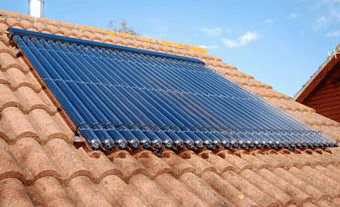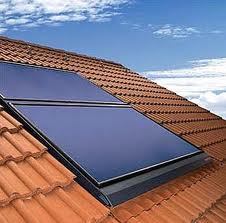Solar Thermal

Solar thermal systems are as with PV, placed on your roof and at first glance look quite similar to Solar PV panels. Their job is to provide a property with hot water by using the sun’s rays to heat water flowing through pipes on the panel.
How it works
 First of all, the Solar collector panels capture the power of the sun and heat the water that is passed slowly through pipes inside the collectors. It then passes through a coil in the household hot water cylinder or heat store, where it heats the domestic hot water supply. A back-up conventional boiler, heat pump or immersion heater is normally used to provide hot water when Solar energy is unavailable.
First of all, the Solar collector panels capture the power of the sun and heat the water that is passed slowly through pipes inside the collectors. It then passes through a coil in the household hot water cylinder or heat store, where it heats the domestic hot water supply. A back-up conventional boiler, heat pump or immersion heater is normally used to provide hot water when Solar energy is unavailable.
There are two types of Solar thermal collector:
- evacuated tubes
- flat plate collectors
Most systems can use either and the main difference is really just the appearance and the temperature at which they operate.
Where it works best
For the collectors, you will need several square metres of roof space, which is in direct sunlight for most of the day. This should be at least partly south facing; though any direction in the southerly arc between East and West will work.
However, do note that the panels don’t always have to be mounted on a sloping roof, they can be fixed to a frame in the garden or on flat roofs.
Solar thermal systems (and air-source heat pumps) are especially popular for heating swimming pools.
Solar thermal systems are dependent on the strength of the sun. They will supply hot water all year round, although will need to be supplemented during winter months. Unlike Solar PV electricity generating systems they are affected by the outside air temperature.
In England, most Solar water heating systems don’t need planning permission, but it is always best to consult your local planning office if you live in a Listed Building, in a Conservation Area or World Heritage Site. If you live in Wales, Scotland or Northern Ireland, you will need to consult your local authority.
How much energy it produces

Solar thermal panels are typically about two square metres each and most average houses would use two to four collectors.
The productivity of Solar radiation does not vary greatly across the UK with typical levels between 1100 kWh per square metre in the South West, to 800 in the Scottish Highlands as shown on this map. Local variations are small and we have reliable meteorological records over many years, so can predict annual outputs and the probability of year-to-year variations quite accurately.
What maintenance it needs
Like Solar PV panels, Solar thermal systems require very little maintenance. Most roof-top sloping systems will clean themselves in the rain which means that we will have very clean Solar thermal in this country.




